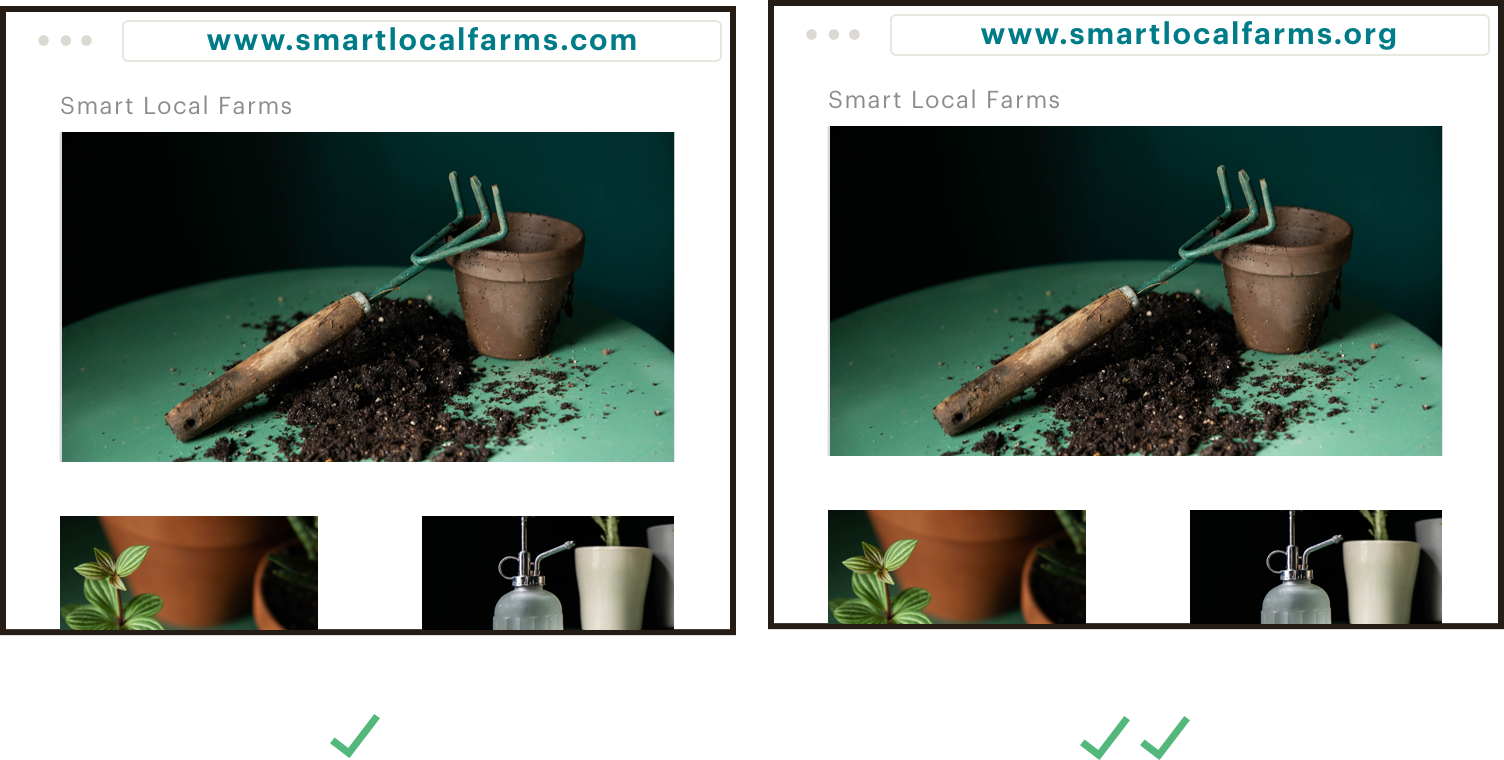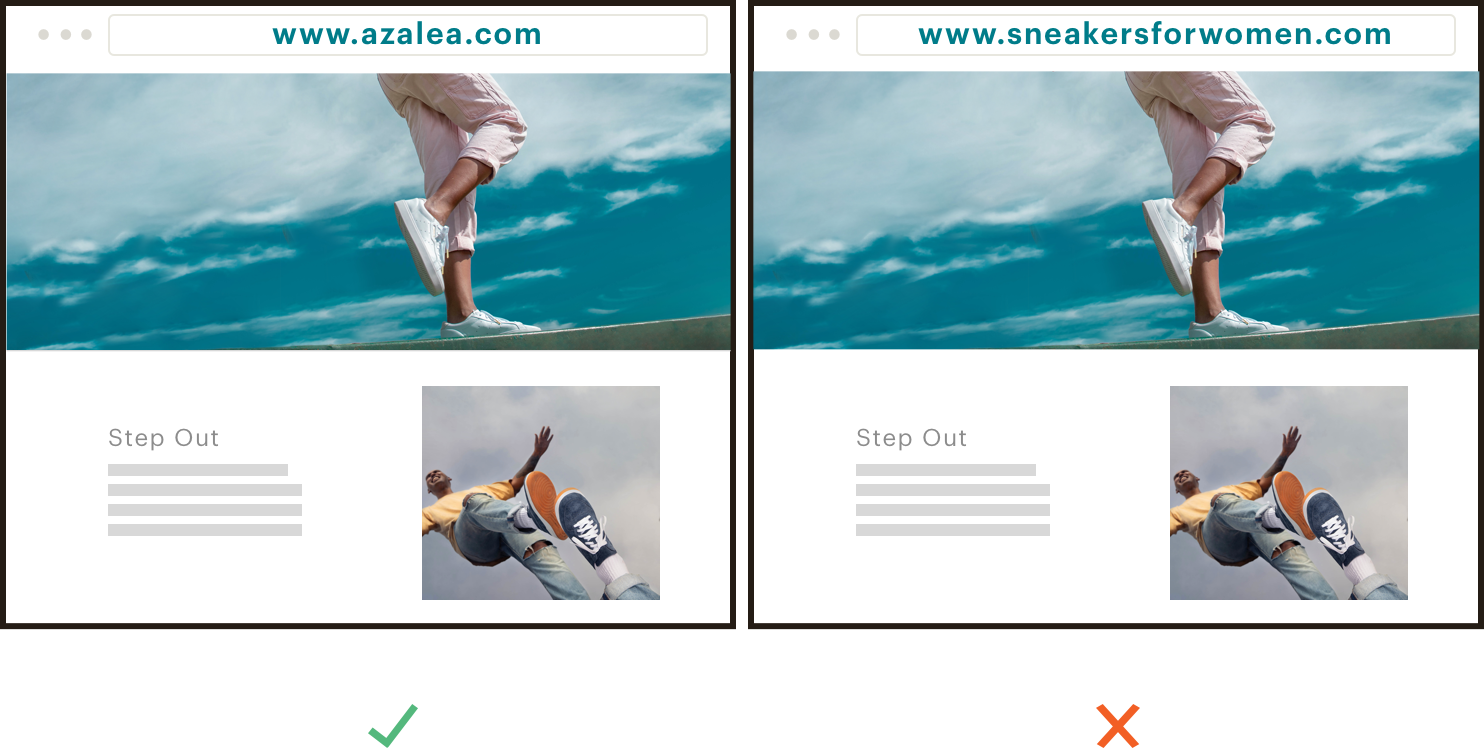What’s a Domain Name? How To Choose the Right One for Your Business
Get tips for finding and buying a domain name, so you can start using it with your website, landing pages, email, or online store.

A domain name is more than just the internet address where people can find your website—it’s the online identity of your business. And choosing the best one for your brand requires some research and consideration.
Domains are affordable and easy to register, and when you buy one through Mailchimp you can use it to unite your website and landing pages under a single, recognizable name. You’ll look more professional and gain instant credibility with your audience.
Domains are affordable and easy to register, and when you buy one through Mailchimp you can use it to unite your website, email, and landing pages under a single, recognizable name.
Finding your domain name
Your domain is made up of 3 main parts—a domain name, an extension (also known as a top-level domain or TLD), and an optional subdomain—that are all important to consider when choosing one that will make it easier for people to find (and recognize) your brand online.

As you’re choosing your domain, keep these guidelines in mind:
1. Keep your domain name short, pronounceable, and ownable
If you already have a business name, try to claim it as your domain. This will make it easier for people to make the connection between your business and your site. No matter what name you choose, it should be easy to type and spell.
Be sure to:
- Keep it 15 characters or less
- Avoid slang (don’t use u in place of you)
- Never include hyphens or numbers
Above all, your domain name should sound like a company name.

2. Try to get .com (but don’t stress if you don’t)
When it comes to choosing a domain extension (the suffix at the end of a web address), there’s some debate about which one will get your website more traffic.
The .com extension is the most popular and easiest to remember, but it might not be the best fit for your brand.
Here are some other top-level domains to consider:
- .org: If you run a non-profit, this will help distinguish you from a for-profit company
- .info: Try this extension if you’re only using your site to share information
- .biz: Got an e-commerce site? This is a good alternative to .com
- .net: A good option if you’re in the tech industry

3. Include keywords if it makes sense
Consider using broad keywords that will help people find you when they search, but don’t overdo it. Getting a more branded domain name might be better for the long-term success of your site than trying to get one that’s keyword-rich.
So instead of going with something very specific, like sneakersforwomen.com, use your business name, like azalea.com, and make sure people recognize you as a women’s footwear brand.

4. See if you can use your domain name for your social handles
Check the availability of your domain name on social media. A unified brand name and identity across all of your channels can help increase your reach.
If your top choice isn’t available on Facebook, Instagram, and Twitter, consider choosing a different one or tweaking your social handles in a way that makes it clear they’re tied to your brand.
Once you’ve got your handles, set up your account profiles on each platform to prevent getting flagged for inactivity.
5. Research the history of your domain name
Make sure your domain doesn’t come with any baggage that you’ll have to deal with later, like trademark conflicts or awkward foreign translations. You don’t want people to confuse you with another brand or, worse, a legal battle if your domain happens to violate any trademarks.
How to register your domain name
After settling on the perfect domain, you’re ready to enlist the help of a registrar. With Mailchimp, you can search for a domain for free and buy it right from your account. Every domain you buy through Mailchimp automatically comes with SSL certification and WHOIS privacy, making it easy to create a secure site experience.
Want to learn more about registering a domain? We have a guide to walk you through the process.
Put your new domain name to work
Now you can use your domain to start marketing your business and building brand recognition.
Get a professional email address
As you build your brand online, use Google Workspace to create an email address for your new custom domain. By sending professional emails from an address like “yourname@yourdomain.com,” you’ll build trust with your customers right from the start.
You’ll also get access to collaborative tools like Google Drive, Sheets, and Slides that make it easy to create and communicate with your whole team. Best of all, you can buy Google Workspace with your domain purchase and get started with your new email address in Mailchimp as soon as you log in.
Learn more about how to get a free domain name from Mailchimp and how our offer compares to the competition.

Build a website
When you’re ready to create an online home for your business, you can use Mailchimp’s drag-and drop website builder to design and publish your site.
Whether you’ve already launched your business or you’re just getting started, you have what you need to manage your online presence in one place:
- A built-in signup form to help you build an audience that’s interested in hearing more about your brand
- Design tools that make it easy to create a site that looks and feels like you without any coding skills
- A published website that’s connected to all your marketing channels, so you can keep everything your customers see consistent

Create landing pages
Landing pages are a type of campaign designed to help you reach a specific goal, like selling a product or getting more contacts.
Whether you’ve purchased a new domain through Mailchimp or connected one you already own, you can set up an unlimited number of subdomains to help you achieve different business goals.
For example, use a landing page to highlight a specific product or collection from your site, and create a unique subdomain that makes it clear what you want visitors to do: Buy that product.
As an alternative to landing pages, with Mailchimp, you can build your online store. Adding products to your Mailchimp store generates individual product detail pages, so you can use those page links in your marketing campaigns and drive sales.

Connect your social accounts
When you connect your social accounts to Mailchimp, you can publish social posts and ads to help you get more eyes on your website and landing pages.
Create a social post to introduce your site to your Facebook, Instagram, and Twitter followers. Promote your landing pages with Facebook and Instagram ads that will drive people to take action faster.
And if your social handles are similar to your domain name, it will be easier for your audience to find your brand wherever it lives online.

Oh, you like trends? We’ve got more.
Whether you’re a brand new SMB owner or a marketing expert, our small business growth and trends report has loads of insights that’ll help you grow and adapt with the times.

